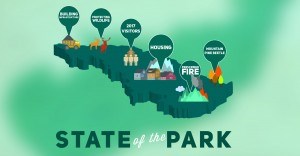
There were no surprises in the annual state of the park address delivered by Alan Fehr, superintendent of Jasper National Park, Feb. 9.
The 30-minute presentation to members of the Jasper Park Chamber of Commerce was a sneak peek of what’s to come in the annual park forum next month. It touched on a number of Parks Canada’s priorities for the next year, from infrastructure spending to building stronger partnerships with the wider community.
The biggest priority, said Fehr, will be overseeing the federal government’s infrastructure program. In July 2015, the Harper government announced $210 million in funding over five years to improve the park’s existing infrastructure. The money is part of $2.6 billion promised by the former government for infrastructure projects in national historic sites, national parks and national marine conservation areas.
Fehr said the agency is currently considering projects for the final three years of the five-year plan, including more bridge work, a major recapitalization of Whistlers Campground, renovations to the heritage fire hall and fixing the parking lots at the Valley of the Five Lakes and Edith Cavell day use areas, although, he pointed out, none of the projects have been confirmed.
Another major priority for the Jasper Field Unit is ensuring the park is prepared to welcome a record number of visitors in 2017, when entry to all national parks will be free of charge to celebrate the 150th anniversary of Confederation.
“We’re expecting record levels of visitation and it’s also a time we’re going to be doing some fairly major construction in certain areas, so that’s going to be something that we’re going to have to juggle,” he said.
On the ecological front, Fehr said the field unit is currently developing a multi-species action plan for the species at risk in the park, such as caribou and whitebark pine.
“Because of the Species At Risk Act, we have to be able to show that we’re taking measures to help with the recovery of these various species,” he said, without giving a specific timeframe as to when the action plan will be publicly released.
The mountain pine beetle is also an area of particular concern for the field unit, especially in light of reports that it continues to spread eastward through the park.
“There’s a variety of concerns that we have and to address those concerns we’re working closely with the Government of Alberta, the Canadian Forest Service and the municipality to complete a mountain pine beetle mitigation plan,” said Fehr.
“Right now the issue is we have these homogenous pine forests that really shouldn’t be there so we’ve got to get fire back on the landscape,” said Fehr, adding the beetle will remain the main thrust for the park’s fire and vegetation program.
Housing was also a topic of conversation during the meeting and is a major priority for Parks.
“It’s high on our radar and it’s something that we’re working on actively with the municipality,” he said, referring to last week’s announcement that two plots of land have been tentatively set aside for development of staff and seniors housing.
During his presentation Fehr reiterated the federal government’s and Parks’ priority to work with Inuit, First Nations and Metis people.
“This is a high priority for the government,” said Fehr, “So this is something we will continue to work on mostly through the Jasper Aboriginal Forum, but also through bilateral relationships as well.”
He also touched on the Learn to Camp program, which was specifically mentioned in the mandate letter from Catherine McKenna, the new minister of environment and climate change.
The letter instructed the minister to expand the Learn to Camp program to ensure that more low- and middle-income families have an opportunity to experience Canada’s outdoors.
Locally, Fehr also touched on several new initiatives that have already been implemented, including the online camping reservation system that was opened three months earlier than last year and the new winter offerings at Marmot Meadows. He also highlighted several events that took place last year, including the Tour of Alberta, the Jasper Heritage Rodeo’s return to the outdoors and stand up paddleboarding at Lake Edith.
He also specifically mentioned the recent acquisition of Maligne Tours by Brewster Travel Canada.
During his brief comments, Fehr commended Pat Crowley, the general manager of Maligne Tours, and Gary Levasseur, the company’s former owner, for their stewardship and he also gave a nod to Brewster.
“Maligne Lake is a special place in Jasper and it really is something we look forward to working on with you.”
The annual Jasper National Park public forum will be held on March 16 at the Sawridge Inn and Conference Centre to discuss the park’s management plan.
Paul Clarke
[email protected]
